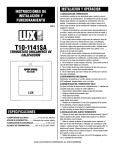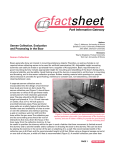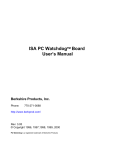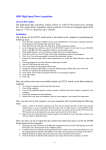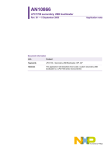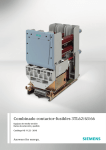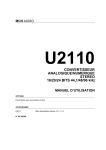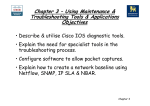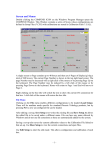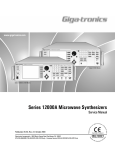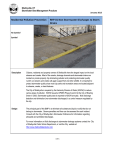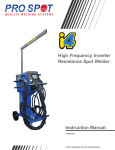Download Computerized Compendium Of Standards
Transcript
Final Report Computerized Compendium Of Standards NSRP 0361 Submitted to: Maritime Administration through: Peterson Builders, Inc. December 18, 1992 Project Director: Howard M. Bunch Principal Investigators: Albert W. Horsmon, Jr. Kurt W. Hagemeister The University of Michigan Transportation Research Institute Marine Systems Division Ann Arbor, Michigan 48109-2150 Technical Report Documentation Page 2 ~smmnt-~a I. ~opofllla Lbd~WrCWtwWo. NSRP 0361 ITWImdSuWt* 5-m December 18.1992 Computerized Compendium of Standards b-ww-hr.Pw(omJnpQg-R.porl~ 7. Author(8) UMTRI-92-31 The Marine Systems Division a HI. Work Unit Na ( T W ) ~llfonning~~~on~.mud~ddmr The University of Michigan Transportation Research Institute 2901 Baxter Road, Ann Arbor, Michigan 48109 11. Conlnct or QmM No. P.O. #1009-0006 I* T y p r o f ~ M d P r i o d C o v m d 12 SpanrorhgAgmyWunrMdAdbru Technical Peterson Builders, Incorporated 101 Pennsylvania St, P.O. Box 650 Sturgeon Bay, WI 54235-0650 14. ~od, Maritime Administration No*r 15. 16. Abbtnd The objective of this project was to develop a compendium of standards (international, national, military, and regulatory ) that have relevance to the U.S. shipbuilding and repair industry. The intended benefits are to provide shipyards with a ready reference to standards that are of use to shipbuilding, and to eliminate the development of new standards where acceptable standards exist. 18. D*Wbu(ion Sh*mnt 17. b y W& Standards, Standardization, Shipbuilding, Indexes, Computerized Indexes lo. swuily a&. (of Wr nport) Unclassified 20. srmly Cuf. pgr) Unclassified 21. No. of P8gn 36 22. Rkr COMPUTERIZED COMPENDIUM OF STANDARDS TABLE OF CONTENTS Report Documentation Page .................. . ...........................................i .. Table Of Contents ................................................................................ii I. Foreword ..................................................................................1 11. Introduction. ..............................................................................2 I11. Problem Definition .....................................................................4 IV . Technical Approach. ...................................................................5 V. Information Handling Service (IHS) .............................................7 VI . Final Results ..............................................................................8 VII . Conclusions and Recommendations...............................................9 VIII . References ...............................................................................10 Appendixes A . Example of IHS File Output ...............................................A- 1 B . List of Compendium Organizations ......... ..........................B-1 C . Compendium User's Manual ...............................................C- 1 I. Introduction ...............................................................C-2 I1. How to Access the Data Base Disk .............................. C-6 I11. Using the Data Base to Locate Information ................... C-8 . . IV . Printing Reports ........................................................C-12 V . Administrative ..........................................................C- 15 Computerized Compendium of Standards I. FOREWORD This report is a product of a program directed by the National Shipbuilding Research Program (NSRP) and the Ship Production Committee (SPC) of the Society of Naval Architects and Marine Engineers (SNAME). This particular research project was sponsored by the Maritime Administration (MARAD) of the United States Department of Transportation (DOT). Peterson Builders Incorporated (PBI) was the prime contractor; University of Michigan Transportation Research Institute (UMTRI) worked under a Subcontract, purchase order # 1009-0006. Under the SPC Panel SP-6 proposal, the technical objective of this project was to develop a compendium of standards (international, national, military and regulatory) that have relevance to the U.S. shipbuilding and repair industry. The intended benefits were to provide shipyards with a ready reference to standards that are of use to shipbuilding and to eliminate the development of new standards where acceptable standards exist. The project was performed at the UMTRI by Albert W. Horsmon, Jr. and Kurt W. Hagemeister, assisted by student Sean Callan. Howard M. Bunch was project director. Computerized Compendium of Standards 11. INTRODUCTION Standards are key elements in the efficient design, construction, and repair of ships and vessels in all shipyards. As a result, there is a continuous need by many designers, engineers, managers, and other people associated with marine work to reference standards from a wide range of regulatory bodies, government agencies, technical societies, and private industry groups. Traditional methods of locating standards center around referencing many documents and books of standards issued by diverse individual organizations. This can not be not only time consuming, but may result in either not finding a standard or developing a new standard where a suitable one may already exist. As a result, Panel SP-6 of the Ship Production Committee of SNAME has identified the need for an up-to-date computerized compendium of standards pertinent to shipbuilding and ship repair. The development of the Computerized Compendium of Standards was contracted for under SP-6 Project P-67. The purpose of this report is to describe the final Compendium data-base and the process used in its development. Section III describes the previous standards-compendium project, some of its limitations, new requirements for a standards compendium based on industry need, and the goals of this project. Section IV explains the four main tasks of this project. The first task was to examine the previous standards compendium and decide how much of it to use as a starting point. Second, a new data-base structure was developed and incorporated into a data-base on a personal computer. Third, new sources for marine standards were researched and a new method to incorporate them into the computer data-base was developed. Finally, data copies of the Compendium and User's Manual were produced to make transfer of the data-base to the industry as efficient as possible. Section V describes the Information Handling Service (IHS) CD-ROMbased standards library and how it was used to gather much of the updated standards information finally incorporated into the Compendium. Section VI summarizes the final results of the project including some size parameters of the final data-base, which information is included, which information is not included, uses for the data-base, and details of some of the major standards types included (i.e., military, ABS, Coast Guard, international). Computerized Compendium of Standards Section VII presents some conclusions of the project with corresponding recommendations of actions to be taken in the future. Finally, the References and Appendix contain supporting information for this report, including a User's Manual. Computerized Compendium of Standards 111. PROBLEM DEFINITION The most recent development of a standards compendium was completed in September 1979 under an NSRP Project titled "A Compendium of Shipbuilding Standards", NSRP 0088, compiled by Corporate Tech Planning for Bath Iron Works under a MARAD contract. The resultant data-base was in the form of a hard-copy paper listing of 2,580 entries from mainly domestic regulatory agencies. At that time, the data-base was issued to the marine industry, only as hard copy, as a reference guide with no provision for ongoing maintenance. The limitations of the 1979 project relative to today's needs were recognized by SP-6 in approving this project. These limitations are: 1. Since 1979, many new standards have been developed, many existing standards have been revised, and some standards have been deleted. Since the original compendium was not revised, it has become outdated and incomplete. 2. The cumbersome form of a hard copy listing makes finding a given standard difficult. With the availability of powerful personal computers and highly flexible data-base software, search times can be greatly reduced with more thorough results. 3. There was no ongoing maintenance requirement defined that provided for input from users into the data-base content or periodic updates based on evolving industry standards. Therefore, in addition to updating the listing of standards to reflect all of the changes since 1979, a major goal of this project was to develop a format for the compendium, which would be easily distributed to users, flexible in manipulating information and searching, and easily maintainable. Also, due to the increased need to reference international standards, the Compendium needed to be broadened to include some of the major foreign standards bodies. The main objective of this project was to arrange all existing standards applicable to U.S. shipbuilding and ship repair into an easily usable computerized data-base that can be updated efficiently on a regular basis. Computerized Compendium of Standards IV. TECHNICAL APPROACH The approach used to complete the project consisted of four main tasks. These tasks were not necessarily sequential in completion and actually had to be refined as aspects of the other parts were developed. The first task was to examine the 1979 Compendium and decide which parts, if any, of it were to be saved. It was quickly decided that all of the data would be retained, at least until it was found to be outdated (if that happened at all). Thus, all twelve data fields for all 2,580 records were retained. This was felt to be the most conservative approach to use and would eliminate any chance of deleting potentially valuable data. The second task was to develop a new data-base format using PC-based software, which would incorporate the fields from the old Compendium, add any new fields that could be useful, and be relatively easy to use for shipyard personnel. The resulting data-base has 12 fields in a rearranged format, which is easier to read in hard copy form. A sub task here was to select a PC data-base software package with which to develop the new format. The main criteria used in this selection were ease of use and learning, flexibility in performing searches, creating reports, etc., and the ability to import and export data in other data-base software formats. This last point is important due to the diversity of data-base programs being used across the industry. As a result, the Alpha F o u program ~ was selected for data-base development. However, the Compendium is shipped as a dBase IV@ data-base at the request of the SP-6 Panel as more commonly in use at shipyards. It is available in Alpha Four on special request from UMTRI. After developing the PC data-base file, it was necessary to begin importing standards. The first major block of data was from the original Compendium. However, since it was not in a format directly readable by Alpha Four, the database had to be converted into a form that Alpha Four could understand. This was done using an optical character reader, which could read text into a structured format that a data-base program such as Alpha Four can recognize as a databasel. Once this was done, the next major task was to begin adding new standards to the data-base, The third task was to research existing information sources to find new standards not already in the Compendium. In particular, an index to international and military shipbuilding related standards needed to be greatly expanded in the new data-base. Due to the volume of standards being sought, the only way to 1 This task was performed by Frank Darvalics in San Diego, CA. Computerized Compendium of Standards efficiently assimilate them into the Standards Compendium was to reference an electronic standards source. For this reason, the Information Handling Service (IHS) CD-ROM data-base was used as a major reference source. (This is described in the next section of the report). In addition, the Code of Federal Regulations and miscellaneous other standards sources not available in electronic format were entered manually. The final task was to produce the Compendium in a format that is easily usable by shipyard personnel and transferable to personal computers anywhere in as efficient a manner as possible. This involved creating an easy-to-follow User's Manual, which explained precisely how to install the Compendium, how to locate information easily, and where to call in case help is required. In addition, report formats were developed that would enable hard copies of searches to be printed quickly. Finally, a method of compressing the Compendium data-base files into an easily shipped form was required due to the volume of data involved. The PKZIP@ software program was selected for this task. As a result, eight highdensity floppy disks' worth of data was compressed onto one disk for shipping to users. With one command (described in the User's Manual) all of the files are loaded onto the user's computer in their original size. Computerized Compendium of Standards V . INFORMATION HANDLING SERVICES As explained earlier in the report, a need was identified at the beginning of the project to find and capture large amounts of standards information electronically. This was deemed the only way to efficiently import to the database file the thousands of new standards necessary to make the Compendium a truly useful tool for industry users. Although this added to the technical complexity of the project, the resource savings in data-entry hours justified the extra programming and computer problem-solving time. As a result, a subscription to the Information Handling services@ (IHS) standards was purchased. IHS provides a data-base subscription service in a CDROM format for many data-bases, including standards. The data-bases are updated on a regular basis to reflect additions, changes, or deletions to standards across a wide spectrum of domestic and foreign standards organizations. The Project Team concluded it was the most complete and easily accessible standards resource available. The IHS data is sent out to subscribers in the form of a CD-ROM disk with accompanying software once each quarter. Using a computer, searches for standards can be carried out included organizations using select criteria specified by the user. In most cases, the search results can be saved to a file or printed for further reference. An example of a search result is in Appendix A. Search criteria were developed that would ensure that most if not all of the marine-related standards were extracted for organizations included on the IHS disks. This task was made easier due to IHS' use of subject indexes and keywords, which helped to eliminate duplicate and non marine standards. A final list of organizations included in the Compendium is included in the Appendix. One final limitation of the IHS disks is that the American Bureau of Shipping standards are not coded to an acceptable level of detail. The original compendium has a much more complete listing for ABS, and these were retained in the current Compendium. In addition, both Coast Guard Navigation and Vessel Inspection Circulars (NVICs) and marine related cites from the Code of Federal Regulations (CFRs) had to be obtained directly. CFR cites were manually entered at the CFR "section" level. Computerized Compendium of Standards VI. FINAL RESULTS The final Compendium data-base contains 10,379 standards from 50 different organizations. This represents a 300 percent increase in size from the 1979 Compendium. With the expansion in military standards, Coast Guard regulations, and foreign standards such as JIS, DIN and BSP, the Compendium offers a much more complete reference source for shipyard personnel. Every standard record entry contains the organization acronym, standard number, descriptive title, and SWBS (Ship Work Breakdown Structure) number. Thus, with the flexibility of the data-base software, searches can be run to find standards meeting a variety of criteria defined by the user. This is a significant improvement from the original Compendium project. The User's Manual, with a more detailed description of the compendium and how to access it, is attached to this report as Appendix C. JIS is Japanese Industrial Standards, DIN is Deutsches Institute fur Normung (Germany), and BSI is British Standards Institute Computerized Compendium of Standards VII. CONCLUSIONS AND RECOMMENDATIONS The following conclusions with corresponding recommendations are hereby presented: 1. In order to make the Compendium an ongoing, usable tool, it will need to be maintained so that it reflects updated standards and references, new standards sources, and archiving of obsolete standards. Also, users will need support and specialized services such as custom searches and ready access to hard copies of standards . RECOMMENDATION: Approve funding for continued maintenance and development of the Compendium. This also includes renewed subscriptions to IHS data. 2. In an effort to continually build the data-base, smaller standardsgenerating organizations that do not fall into the IHS data-bases and other standards directories should be researched and added. RECOMMENDATION: Approved funding per item 1. This should be included in a maintenance effort. 3. Military standards should be extended to include 2nd-tier standards for those standards referenced by the major (1st-tier) standards. This would improve the usefulness of the data-base even more, especially for military users. RECOMMENDATION: Should maintenance projects be approved, work with IHS or the Navy to develop a method of extracting 2nd-tier standards. Computerized Compendium of Standards VIII. REFERENCES 1. "A Compendium of Shipbuilding Standards" NSRP 1979 by Corporate Tech Planning for Bath Iron Works. 2. Information Handling Services, Denver Colorado, CDROM subscription service, 1991-1992. 3. Code of Federal Regulations, U.S. Government printing office, October 1990, parts 1-588.8. DODISS 92-03 Document Number Information Handling Services Page 1 St Title OARS MATS, CARGO LADDERS, JACOB ' S FURNITURE, SHIPBOARD, STEEL, GENERAL SPECIFICATION FOR MIL-C-486B CANC NOTICE H CHAIRS, SHIPBOARD, STEEL (USE AA-C-275) 1 MIL-G-613C (1) A GRAPNELS, MARINE, TRIP WIRE, AND CRASH TRUCK MIL-F-902J (2) A FURNITURE, SHIPBOARD, ALUMINUM: GENERAL SPECIFICATION FOR MIL-M-1158B (3) H MIRRORS, GLASS, SHIPBOARD USE MIL-A-2 673 H ANCHOR, STEEL, NAVY TYPE OR STOCKED MIL-B-2 680 A BUOYS, ANCHOR, SPAR MIL-G-2 697A (2) A GLASSES, PORTLIGHT, CIRCULAR, HEAT TREATED MIL-S-2734B (1) A STRAP, BERTH, MATTRESS RETAINING MIL-G-2767C (1) A GUARDS, RAT, SHIP MIL-F-2807A CANC H FENDER, MARINE COIR ROPE NOTICE 1 MIL-G-2860E A GLASSES, SIGHT-FLAT, CLEAR, BOROSILICATE MIL-H-2946 CANC NOTICE H HOISTS, AMMUNITION, AUTOMATIC-DREDGER- TYPE, AND POWER-EQUIPMENT 1 MIL-A-3339C VALID A ANCHORS, SEA, LIFE RAFT NOTICE 1 MIL-W-3459D A WIPERS, WINDOW, ELECTRIC, PENDULUM TYPE (MARINE SERVICE, HEAVY DUTY) HOOKS, BOAT (BALL POINT) BERTH BOTTOM, DUCK COTTON CLOTH (CANVAS), BIAS CUT MIL-R-3768B CANC H REPAIR EQUIPMENT, PLYWOOD BOAT AND PONTON, PACKAGING NOTICE 1 MIL-B-5006 CANC NOTICE H BUOYS, SEAPLANE MOORING 1 MIL-I-5284A H INTERFERENCE LIMITS, AIRBORNE LIFEBOAT GENERAL SPECIFICATION FOR MIL-1-6142 CANC NOTICE H AIRCRAFT EMERGENCY ESCAPE SYSTEM, 1 IDENTIFICATION OF (SUPERSEDED BY MIL-A-25165) MIL-0-8626A CANC H OAR, METAL, SECTIONAL NOTICE 1 MIL-P-11064C CANC H PAD EYES: DECK SNUBBING NOTICE 1 MIL-F-11435A CANC H FENDERS, MARINE, RUBBER-FILLED NOTICE 1 MIL-B-12203B CANC H BAG, BOAT PADDLE NOTICE 1 MIL-R-12500A CANC H REPAIR KIT ROLL, PNEUMATIC FLOAT, TOOL, DUCK COTTON CLOTH NOTICE 1 MIL-P-12581B CANC H REPAIR KIT, INFLATABLE CRAFT, FOR BLADDER TYPE OR NONBLADDER TYPE BOATS, PACKAGING OF NOTICE 1 H ANCHOR, MARINE, FLUKED, KEDGE TYPE, WELDED, MIL-A-13480A CANC NOTICE 1 100 LB. MIL-0-3 9A MIL-M- 69A ( 1) MIL-L-221C MIL-F-243E (2) A A A A Appendix A Page 1 Standards Compendium standards Organizations and Sources in Database ABS ABS 01 ABS 02 ABS 03 ABS 04 ABS 05 ABS 06 ABS 07 ABS 08 ABS 09 ABS 10 ABS 11 ABS 12 ABS 13 ABS 14 ABS 15 ABS 16 ABS 17 ABS 18 ABS 19 ABS 20 ABYC AFNOR AMCA ANSI API ASTM BSI Bundesam American Bureau of Shipping Rules for Building and Classing Steel Vessels Nondestructive Inspection of Hull Welds Approved Welding Electrodes Wire-Flux & Wire Gas Combinations Offshore Mobile Drilling Units Steel Barges for Offshore Service Bulk Carriers for Service on the Great Lakes River Rules '7 1 Inert Gas Installations on Vessels Carrying Oil in Bulk Certification of Cargo Containers Manual for Making Bronze Propeller Repairs Repair, Welding, Cladding & Straightening of Tail Boilers Burning Crude Oil & Slops in Main & Auxiliary Boilers Steel Floating Drydocks Underwater Inspection in Lieu of Drydocking Survey Construction of Shipboard Elevators Certification of Construction & Survey of Cargo Gear on Merchant Vessels Certification of Self-unloading Cargo Gear on Great Lakes Vessels Single Point Moorings Aluminum Vessels Classification of Nuclear Ships Submersible Vessels American Boat and Yacht Council, Incorporated Association Francais de Normalisation (France) Air Moving and Conditioning Association, Incorporated American National Standards Institute American Petroleum Institute American Society for Testing and Materials British Standards Institute German Standards Appendix B 1 CGNVIC DEF - S DIN DOD DOL EPA FCI FED-SPEC GL HE1 HI IEC IEEE IES IMCO IPCEA IS0 JIC JIS MARAD MASS MASSD MIL MSS NBS NEMA NFPA NNI OCMIF PCC SAA SCA SNAME SOLAS SSPC TEMA U.S. Coast Guard Navigation and Vessel Inspection Circular British Defense Standards Deutsches Institute fur Normung (Germany) Department of Defense Department of Labor Environmental Protection Agency Fluid Controls Institute, Incorporated Federal Specification Germanisher Lloyd Heat Exchange Institute Hydraulic Institute International Electrotechnical Commission Institute of Electrical and Electronics Engineers, Incorporated Illuminating Engineering Society Intergovernmental Maritime Consultive Organization Insulated Power Cable Engineers Association International Organization for Standardization Joint Industrial Council Japenese Industrial Standards Maritime Administration MARAD Standard Specification MARAD Standard Specification - Diesel Military Specification Manufacturers Standardization Society of the Valve & Fittings Industry National Bureau of Standards National Electrical Manufacturers Association National Fire Protection Association Netherlands Normalisatie Instituut Oil Companies International Marine Forum Panama Canal Company Standards Association of Australia Suez Canal Authority Society of Naval Architects and Marine Engineers Safety of Life at Sea Steel Structures Painting Council Tubular Exchanger Manufacturers Association Appendix B 2 UL USCG USDA USN USPHS Underwriters Laboratories, Incorporated United States Coast Guard United States Department of Agriculture United States Navy United States Public Health Service Appendix B STANDARDS COMPENDIUM DATA-BASE USER'S MANUAL Table of Contents I. Introduction ..........................................................................................2 11. How to Access the Data-base Disk............................................................5 111. Using the Data-base to Locate Information ...............................................7 IV. Printing Reports ....................................... .. .........................................11 . . 14 V. Adm~nistrative ........................ Appendix C 1 STANDARDS COMPENDIUM DATA-BASE USER'S MANUAL I. INTRODUCTION Overview The Standards Compendium Data-base has been developed to provide an up-to-date reference list of all existing marine-related standards. The data-base is intended as a resource to the shipbuilding, ship design, and maritime industries for standards that have been developed by various organizations to aid in boat and ship construction. Users will be able to locate standards of interest using a DOS PC and the data disks provided by UMTRI, (currently the organization responsible for developing and maintaining the data-base). The Standards Compendium will be updated periodically to reflect changes in the current body of marine standards as well as to enhance the system based on user input. The data-base contains basic descriptive information of each standard (organization, number, title) along with current revision and administrative data. There will be sufficient information on each standard so that a user can determine if it is suitable for a given purpose. A user should then be able to determine whether it is necessary to reference a detailed standard. All major standards-generating organizations have been included, both U.S. and international. See Appendix B for a list of the organizations included in the Compendium. In developing the Standards Compendium data-base, the 1979 National Shipbuilding Standards Program data-base was used as a starting point, with these standards being updated and new ones added. The basic data-base structure was kept intact and some new fields were added. The Compendium was developed using PC-based data-base software; Alpha FourTM and dBASE IV@versions are available. Contents of the Users Manual This User's Manual contains information to help new users of the Compendium install the data-base on their computers, learn how to find information quickly, print out reports, and locate help should problems arise. The manual is divided into 6 main sections: Appendix C I. 11. 111. IV. V. VI. Introduction How to Access The Data-base Disk Using the Data-base to Locate Information Printing Reports Administrative Appendix Hardware and Software Requirements The following are recommended hardware and software requirements for the Standards Compendium. * IBM PC compatible, at least a 286 * 640K RAM with 1 megabyte or more * Hard drive with at least 8 megabytes free * 5.25 or 3.5-inch high-density disk drive * Major data-base software program such as dBASE IV, Paradox, Alpha Four, etc. * Dot matrix or laser printer (if printing is desired) Note that the Compendium can be shipped in different floppy-disk sizes and data-base formats, depending on each user's requirements. Data Included in the Data-base In general, the data in the Compendium has been obtained from the most recent versions of the standards available. Not all data field information is available for each standard. These fields were left blank, although there is a possibility they will be filled in a future revision of the data-base. The following are names and descriptions of each of the data fields in the Standards Compendium: FIELD DESCRIPTION ORGAN Standards organization that originated the Appendix C 2 standard (see the listing in the Appendix of organizations included) SWBS Navy ship work breakdown structure applicable to the standard (see the listing in the Appendix of this manual) STD-NO Standard number as assigned by issuing organization TITLE Descriptive title of the standard ORIGDATE Date the standard was originally issued REV-NO Revision number REV-DATE Date the standard revision was issued SUBJECT Major work breakdown structure category MOD-REQD Code indicating whether a revision is due or not a e s or No) STD-TYPE Code for the type of standard: 1 2 3 4 The standard establishes definitions or classifications. The standard is used primarily in design. The standard is used primarily in production operations. The standard is used primarily in test and/or inspection activities. 5 The standard defines limits or boundaries (specifications) on the characteristics of materials, items, systems, or services. ENGLISH Code that indicates whether an English version of the standard is available (Iles or No) ADDTL-STD Other standards relating to the current standard Note: It is expected that not all of the above fields will be pertinent to every standard. Also, some data will not be available. However, these fields will encompass most of the useful information for each standard in the Standards Compendium data-base. Appendix C 4 Notes on Military Standards Most references to military standards in the data-base were taken from the Information Handling Services (IHS) standards disks. However, due to program limitations, it was only possible to extract basic fields such as title, standard number, and organization. Future revisions of the data-base will correct this problem so that other fields such as revision number and revision date can be extracted easily. All military standards are coded in the Compendium under the organization DOD. The were 2,601 new military standards obtained for this Compendium. Most of these standards are primary first-level standards. There are a great many more standards referenced by these first-level standards. For example, a fuel-oil service-system standard may refer to a standard for copper-nickel piping, among many others. The reference standards are not included in the Compendium in most cases. For government applications, these references are available through the Naval Sea Systems Command, NAVSEA Where to Call With Ouestions/Problem~ If you are having any problems with the Compendium or have questions about any aspect of using it, call the University of Michigan Transportation Research Institute (UMTRI) at (3 13) 764-5308, (FAX 3 13-936-1081). Or, you can write to: University of Michigan Transportation Research Institute Marine Systems Division 2901 Baxter Rd. Ann Arbor, MI 48109-2150 Attn: Standards Compendium Appendix C 5 11. HOW TO ACCESS THE DATA-BASE FILE General The data-base will amve on one 3.5" disk in dBASE IV format. The first necessary task will be to make a backup copy of the database. This will protect valuable data in case of hard-drive or floppy-disk damage. Use the DOS DISKCOPY command with this format: DISKCOPY A: A: (To copy using a one drive system with the same type of disk) or DISKCOPY A: B: (To copy using a two drive system from the 5.25" disk to a 3.5" disk) Note: It is important to number each of the copy disks (if you receive more than one disk) the same as the originals. This will help ensure that the disks are read onto the hard drive in the correct order. Uncompressing the Files. Loading onto the Hard Drive The Compendium will be sent to users in a compressed-file format so that the data-base and all associated files can fit on one data disk. The data-base files have been compressed using the PKZIP.EXE program into one file called COMPEND.ZIP. In order to load the Compendium files onto the hard drive and restore them to normal size, it will be necessary to use the PKUNZIP command. After making a backup copy of the Compendium disk, use the copy to load the database to the hard drive in your computer. It will be necessary to use the PKUNZIP command to uncompress (extract) the files and load them onto the hard drive. This program will be included on the disk each user receives and can be run using the following command (at the DOS prompt): B :\, PKUNZIP COMPEND.ZIP C:\COMPEND\ In this example, the user has the Compendium disk in the B drive (on some computers this will be the A drive) and is extracting the data-base files from the Compend.Zip file into the COMPEND directory on the computer's C hard drive (The user can name the directory by some other name if desired). The Compendium data-base can be put in any directory or subdirectory desired. However, it would be a good idea to put the files in an easy-to-find location. Once the PKUNZIP command has been successfully completed, all of the Appendix C 6 necessary data-base files will be on the User's hard drive ready to access with the data-base program. There will need to be at least eight megabytes of free memory space on the computer hard drive in order to load the Compendium data-base and its supporting files. If there is insufficient memory, options for obtaining more space include deleting obsolete files to create more space, finding another computer with enough free memory, or obtaining a larger hard drive. Using Different Data-base Programs The Standards Compendium was developed using the Alpha Four data-base software program. However, the Compendium is supplied in dBASE IV. The Alpha Four version is available upon request from UMTRI. The data-base files can be accessed with other data-base programs if saved in the correct file format. In either case, it will be possible to directly read the files with your data-base program without any file-conversion programs. Problems with access in^ the Com~endiumData-base Upon successful loading of the Compendium onto the computer, it can be accessed simply by loading the data-base software program into memory and choosing MAIN.DBF as the active data-base file. If MAIN is not available as a choice, it may be necessary to change the default directory currently set up in the data-base software to C:\COMPEND (or whichever directory path the data files were moved to). The default directory is the location where the software program automatically looks to find files to load. This directory can be named whatever one wants. Most users choose an easy to remember name where they want all their data-bases to reside. Appendix C 7 111. USING THE COMPENDIUM TO LOCATE INFORMATION This manual uses the dBASE IV command language to describe search methods. Most data-base software programs use similar, if not identical commands. The title of the command may be different, but usually the function is the same. This section of the manual will describe the basic steps for locating the available information. Experienced data-base-software users will be able to use more advanced techniques tailored to their individual needs. Assuming that the data-base program is loaded onto the computer hard drive, call it up using the appropriate command at the DOS prompt, (or if you are in the Windows environment, double click on the program icon under nonWindows Applications). At the Control Center, the data-base, the queries, and the reports are available by command. There are two ways to look at the Main data-base file. You can use the Query command at the Control Center or you can use the ORGANIZE command when editing data. We recommend using the QUERY command. Both methods are described below. There are a variety of ways to search the data-base depending on what information is being sought and how often the query will be required. dBASE IV is very flexible in letting users define queries using either very broad criteria or narrow search parameters. This section gives a general description of how to set up queries as well as examples of some common queries that will be used with the Standards Compendium. Each of the popular data-base software programs has very flexible command structures for creating queries. Most programs allow a search for key words or character strings from one or more data fields concurrently. Also, it is usually possible to link different search criteria using logical operators such as AND or GREATER THAN. Appendix C 8 For example, a query can be set up in B A S E IV to find all ABS standards pertaining to boilers with a standard number greater than 25. Remember the expression field has to be enclosed in quotes. This would involve setting up three search criteria as follows: CRITERIA FIELD OPERATOR EXPRESSION 1 2 3 ORGAN STD-NO TITLE - ABS $ 25 BOILER > In the above, $ is a dBASE IV operator, which tells the program to search for any occurrence of the word boiler in the specified field. Another simple, commonly used type of search is to find all records with the same entry in the primary index. For example, if the current query is By Organization (within dBASE IV), the Find command can be used to jump to the first SNAME record, for example. The user can then page through the records. The searches that Compendium users will probably employ most of the time are: 1. Search for a specific standard number - possibly within a given organization. 2. Search for standards with a specific SWBS - possibly within a given organization. 3. Search for all standards related to one or several key words or expressions (for example, all standards related to Halon Systems). Using Oueries To use established queries, simply activate one of them. For example, to find all standards issued by the American Boat and Yacht Council in the short version, you would activate the Organization Order - short version (ORGSHORT) Query. Appendix C 9 Creating a new query is desirable if you want to view the records using a field other than the established ones as the main sort. To create a query sorted in order of the ASTM subcommittee responsibility, select QUERY from the B A S E IV Control Center. There are complete instructions on how to do this in the dBASE IV Manual (Using dBASE IV, Chapter 6). Oueries Available The data-base can be displayed on the screen sorted by any field desired. Each sort of the data-base is called a query. A query is called up from the Control Center. The main data-base file is exactly the same no matter which query is chosen. The records will simply be displayed in a different order. Within the query file there are primary indexes and secondary indexes. The primary index is the field used to sort the records on the screen. The secondary index(es) is the field to sort by within the primary index field. For example, within the Organization primary index field, one may want to sort all entries by Standard Number (the secondary index field). The Compendium has been shipped with four Queries available (these were the ones that are considered most useful): QllmaB 1. By Organization Order - short version 2. By Organization Order - long version 3. By SWBS Order - short version 4. By SWBS Order - long version dBASE IV Name ORGSHORT ORGANLND SWBSSHRT SWBSLAND If there are other queries that would be useful, the Query Create command can be used to set up and save a new query. Saving Oueries and Ouery Results Frequently accessed queries should be saved under a file name for use in the future. Queries can also be saved as a new (mini) data-base. In dBASE IV, this can be done using the "LAYOUT - SAVE THIS QUERY" command in the Query Menu. If the query is needed again in the future, it can be retrieved easily at the Control Center. Appendix C 10 Using Indexes To use an established index, simply activate one of them. For example, to find all standards created by the American Boat and Yacht Council in the short version, the user would activate the Organization (ORGAN) Index. With the main data-base active, the user can choose an index other than the current index as long as he/she in the dBASE IV Control Center. Press F2 (Data), select ORGANIZE and highlight ACTIVATE INDEX FILE. dBASE IV will then present a list of the available indexes which can be selected by simply highlighting and entering. Creating a new index may be desirable if the user needs to view the records using another field as the main sort. An example of this would be to create an index sorted in order of the Subject category. To do this, select ORGANIZE from the dBASE IV Control Center and choose CREATE AN INDEX. dBASE IV will then ask for the filename under which the index file is to be saved. There are complete instructions on how to do this in the dBASE IV Manual (Using dBASE IV, Chapter 5). Browsing Through Records From the dBASE IV Control Center, begin browsing through records by using the F2 (Data) command. dBASE IV starts at the beginning of the database by default and shows multiple records at once. This is called the Browse mode, and will display each record on one line. It will still be possible to see other data fields within the record by scrolling to the right until the desired field comes onto the screen. To look at a single record at a time, press the F2 (Data) button, this will put you in the Edit mode. To go back to Browse mode (multiple records at a time) press the F2 button again. Using the Tab key causes the cursor to move one field at a time. To scroll forward 17 records, use the Page-Down key, using the Page-Up key results in a backward scroll of 17 records. Ex~ortineData from the Data-base If necessary, records can be exported to another file in a selected data-base software format. This is done in dBASE IV using the TOOLS/EXPORT DATA command. There is a lot of flexibility in determining which fields and records are selected for export. One advantage to doing this is the ability to manipulate some of the data in another file without altering the structure of the original database. Appendix C 11 IV. PRINTING REPORTS Printing reports can be done in several different ways. The Compendium has been sent out with report formats already set up. To print, enter the Report menu and select the desired report format. Another way is to design a custom report using the software. This is of course, much more time consuming. However, it does afford a lot more flexibility in tailoring a report to specific needs. This section of the manual provides printer and hardware requirements necessary for printing, describes the available report formats, and briefly explains how to design reports using B A S E IV. Hardware Requirements dBASE IV, or any of the common data-base software packages, functions well with either dot matrix or laser printers. The software provides a menu of printers from which a user can select one that is compatible with hisher printer. Either letter size or wide computer paper can be used to print listings of standards. Several of the report formats provided with the Compendium are designed to fit on letter size paper. A desirable feature for printers is the ability to use "compressed mode". This is helpful when printing large listings of standards, so that more information can be fit onto a page. Report Formats Available In the dBASE IV version shipped to Compendium users, there are four report formats available to choose from. These were the listings assumed to be the most useful for the majority of users. Any of the four formats can be used to print a list of standards of any length. Below are descriptions of each: 1, Qganization order - short version This report lists the standards in alphabetical order of the originating organization. Within each organization, the standards are in ascending numerical order. The fields included are the ones expected to be of the most interest: Organization, Standard Number, Standard Title, Origination Date, and Revision Number. 2. Qrganization order - long version This report lists standards in the same order and logic as the above report, except that all data fields are included. In order to print this report a wide carriage printer and paper are required. Appendix C 12 3. $WBS order - short version This report lists the standards in ascending SWBS order with organization being the secondary sort. The fields included are ORGANIZATION, STANDARD NUMBER, STANDARD TITLE, ORIGINATION DATE, AND REVISION NUMBER. 4. SWBS order - long: version This report lists standards in ascending SWBS order with organization being the secondary sort. All data fields are included in this report. Again, a wide carriage printer is required in order to fit all of the columns onto one page. When ready to print, dBASE IV displays a list of report formats to choose from under the Control Center Report Menu command. How to Print a Report Printing a report is straightforward using one of the predefined formats in dBASE IV. Basically, this tells the program which fields to print, in what order on the page and in which locations. Also, the format tells the program what to print on the top and bottom of the page in the way of heading and summary information. The dBASE IV commands to use in printing are simple, once a report has been created to print from a querylmain data-base. Suppose a search is run that results in a list of 150 records, It is necessary to tell dBASE IV to begin printing. All 150 records will be printed using the format chosen. Creating a Custom Report Printing does not have to be done using one of the predefined report formats. The software will allow users to design a report form. This usually takes a little effort, but may be worth it depending on which fields are most useful as well as what is the best order to print in. In dBASE IV, the basic command to use in setting up a new report is Reports, and then CreateJModify a Report. After the report has been set up, in the Layout Save This Report, a file name will be needed to store the report in, a report description, and which data fields need to be printed in the report. The further details of how to create a custom report are beyond the scope of this manual. However, the software user's manual will provide detailed Appendix C 13 instructions on all the commands. Beyond this, it will take some working with the software to become proficient at setting up a report. Examples of Reports Following the administrative section are example pages of the different report formats available. Appendix C 14 . V ADMINISTRATIVE sed C o ~ i e of s the Data-base The Standards Compendium can be obtained through a written request to the University of Michigan Transportation Research Institute (UMTRI), Marine Division, 2901 Baxter Rd., Ann Arbor, Michigan 48109-2150, or via a phone call to the NSRP Documentation Center at the same address at (313) 763-2465. Custom Services Available Custom searches and information retrieval from the Standards Compendium is available at moderate cost from UMTRI. Requests should be made to the address and phone listed above. Making Change R e a u Proposed changes can be made to the Compendium in writing using the form included at the end of this appendix. Changes may take the f o m of: 1. Additions of new standards 2. Changes to one or more fields included in the current version of the Compendium. 3, Deletions of standards in the Compendium. 4. Changes to the Compendium program and data-base structure. This would include adding new data fields or different report formats, for example. All change requests will be reviewed by the Compendium program administrator. The main criteria for acceptance will be usefulness to users, availability of data, and cost. The originator will be notified in writing of the decision by the program administrator. If a change of general benefit to users involves significantly higher cost than current funding allows, the change will be discussed at an SP-6 meeting. Appendix C 15 STANDARDS COMPENDIUM LISTING Short Version By SWBS SWBS ORGANIZ. NAME STANDARD NO. STANDARD TITLE * * * * * * * * * * * * ************ . . . . . . . . . . . . . . . . . . . . . . . . . . . . . . Green Bananas - Guide to IS0 799 Page No, ORIGINATION REV DATE NO. ********** *** Storage and Transport First Edition 000 API PUBL 441 Development and Evaluation of the OCD/API Model 000 API PUBL 430 Offshore Petroleum Operations on Cold Water Marine Mammals, Effects of; A Literature Review 800 CGNVIC REGIONAL EXAMINATION CENTERS; ADMININSTRATION POLICY FOR THE ISSUANCE OF MERCHANT MARINE LICENSES AND CERTIFICATES 1982 000 CGNVIC MSD CERTIFICATION 1982 000 CGNVIC COAST GUARD RETENTION OF COMMERCIAL VESSEL PLAN REVIEW CASE FILES 1983 000 CGNVIC REGULATIONS FOR VERY LARGE 46 CFR SUBCHAPTER T PASSENGER VESSELS 1983 000 CGNVIC PILOT TRANSFER ARRANGEMENTS 000 CGNVIC DETERMINATION OF COLD WATER AREAS 000 CGNVIC ISSUANCE OF LETTERS OF COMPLIANCE TO FOREIGN DOCUMENTED MOBILE OFFSHORE DRILLING UNITS OPERATION ON THE OUTER CONTINENTAL SHELF OF THE UNITED STATES 000 DEF S NES 20 Functions and Responsibilities of Warship Procurement and Design Authorities Issue 1 (11/82) 000 DOD NAVSEA 4710. 11/18/82 (SEA 0743/TLC) PRIVATE SECTOR DEPOT-LEVEL AVAILABILITY PLANNING FOR NAVAL SURFACE SHIPS; POLICIES, PROCEDURES, AND RESPONSIBILITIES FOR 000 DOD NAVSEA 5450. 08/01/83 (05A4/JP) NAVAL SEA SUPPORT CENTER, ATLANTIC, PORTSMOUTH, VA AND NAVAL SEA SUPPORT CENTER, PACIFIC, SAN DIEGO, CA; MISSION AND FUNCTIONS OF Appendix C 16 1 STANDARDS COMPENDIUM LISTING Short Version By Organization 3RGANIZ NAME . SWBS STANDARD NO. STANDARD TITLE ******** ************ .............................. U S 30.13 WELDING STRUCTURE, CLASSIFICATION, JOINT, WELDED, WELD, HEAT TREATMENTS PageNo. 1 ORIGINATION REV DATE NO. ********** *** 3 RADIOGRAPHY, BOILER AND PRESSURE VESSEL RADIOGRAPHY, PIPE CONNECTION TEST, HYDROSTATIC, TEST, BOILER METAL, FILLER, TEST, WELD, TEST, WELD, NONDESTRUCTIVE ABS WELDER, QUALIFICATIONS ABS RIVET, BOILER, BOILER RIVET ABS FORGING, MACHINERY , STEEL FOR TEST, STEEL FORGING CASTING, STEEL FOR MACHINERY, BOILER AND PRESSURE VESSEL TEST, CASTING, STEEL CASTING, REPAIR ms CASTINGS, NODULAR IRON FOR MACHINERY TEST, IRON CASTING ABS CASTINGS, GRAY IRON FOR MACHINERY TEST, GRAY IRON CASTINGS ABS TRIALS, ELECTRICAL EQUIPMENT A .S TEST, AUTOMATIC CONTROL SYSTEM TRIALS, AUTOMATIC CONTROL SYSTEM MATERIALS I SCANTLINGSI STRUCTURAL SECTION STEEL, HULL, TESTS AND INSPECTIONSI STEEL, HULL, PLATE THICKNESS TOLERANCES STEEL, HULL, STEEL, HULL, TREATMENT OF SURFACE DEFECTS ABS STEEL, HULL, HIGHER STRENGTH ABS STEEL, FOR LOW TEMPERATURE REQUIREMENTS CASTING, HULL STEEL, TEST, HULL STEEL CASTING FORGING, HULL STEEL, TEST, FORGING, HULL STEEL Appendix C 17 3 STANDARDS COMPENDIUM LISTING Sort By SWBS - Long Version SWBS ORGAN STANDARD NUMBER **** ******** ************ TITLE OF STANDARD ....................................................... Green Bananas API PUBL 441 API PUBL 430 - Guide to Storage and Transport First Edition Development and Evaluation of the OCD/API Model Offshore Petroleum Operations on Cold Water Marine Mammals, Effects of; A Literature Review Page No. STD TYP ORIGIN. DATE REV NO. REVISION DATE REV STA MOD REQ SUBJECT ENGL VER? ADDITIONAL STANDARDS *** ******** *** ******** *** *** ********** **** a********* Yes Yes Yes REGIONAL EXAMINATION CENTERS; ADMININSTRATION POLICY FOR THE ISSUANCE OF MERCHANT MARINE LICENSES AND CGNVIC CERTIFICATES MSD CERTIFICATION CGNVIC CGNVIC COAST GUARD RETENTION OF COMMERCIAL VESSEL PLAN REVIEW CGNVIC CASE FILES REGULATIONS FOR VERY LARGE 46 CFR SUBCHAPTER T CGNVIC PASSENGER VESSELS PILOT TRANSFER ARRANGEMENTS CGNVIC CGNVIC DETERMINATION OF COLD WATER AREAS ISSUANCE OF LETTERS OF COMPLIANCE TO FOREIGN DOCUMENTED MOBILE OFFSHORE DRILLING UNITS OPERATION ON THE OUTER CONTINENTAL SHELF OF THE UNITED STATES DEF S NES 20 Functions and Responsibilities of Warship Procurement and Design Authorities Issue 1 (11/82) 000 DOD NAVSEA 4710. 11/18/82 (SEA 0743/TLC) PRIVATE SECTOR DEPOT-LEVEL AVAILABILITY PLANNING FOR NAVAL SURFACE SHIPS; 000 DOD NAVSEA 5450. 08/01/83 (OSA4/JP) NAVAL SEA SUPPORT CENTER, ATLANTIC, PORTSMOUTH, VA AND NAVAL SEA SUPPORT CENTER, PACIFIC, SAN DIEGO, CA; MISSION AND FUNCTIONS OF 000 DOD OPNAV 4760.1 08/25/80 (OP-35) FLEET INTRODUCTION PLAN FOR GUIDED MISSILE CRUISER TICONDEROGA (CG 47) 000 DOD SPAWAR 4860. 07/31/90 (SPAWAR 003-211) GOVERNMENT FURNISHED EQUIPMENT (GFE) MANAGEMENT SYSTEM (GMS) 000 DOD SECNAV 7700. 08/01/90 (NIG-00) INFORMATION REQUIREMENTS FOR SEMIANNUAL REPORT TO THE CONGRESS 000 DOD SECNAV 5031. 05/17/89 (CHINFO) SHIP NAMING, CHRISTENINGS AND COMMISSIONINGS 000 DOD SECNAV 5740. 10/22/54 (SO-4:RSH) MEMORANDUM OF AGREEMENT BETWEEN THE DEPARTMENT OF DEFENSE AND DEPARTMENT OF COMMERCE, POLICIES, PROCEDURES, AND RESPONSIBILITIES FOR 1 Yes STANDARDS COMPENDIUM LISTING Sort By Organization - Long Version ORGANIZ SWBS STANDARD TITLE OF STANDARD NUMBER ******** **** ************ TYP ........................................ ABS WELDING STRUCTURE, CLASSIFICATION, JOINT, WELDED, WELD, HEAT TREATMENTS ABS RADIOGRAPHY, BOILER AND PRESSURE VESSEL RADIOGRAPHY, PIPE CONNECTION ABS TEST, HYDROSTATIC, TEST, BOILER ABS METAL, FILLER, TEST, WELD, TEST, WELD, NONDESTRUCTIVE WELDER, QUALIFICATIONS ABS ABS ABS RIVET, BOILER, BOILER RIVET FORGING, MACHINERY, STEEL FOR TEST, STEEL FORGING ABS CASTING, STEEL FOR MACHINERY, BOILER AND PRESSURE VESSEL TEST, CASTING, STEEL CASTING, REPAIR ABS CASTINGS, NODULAR IRON FOR MACHINERY TEST, IRON CASTING CASTINGS, GRAY IRON FOR MACHINERY TEST, ABS TRIALS, ELECTRICAL EQUIPMENT ABS TEST, AUTOMATIC CONTROL SYSTEM TRIALS, AUTOMATIC CONTROL SYSTEM ABS MATERIALS, SCANTLINGS, STRUCTURAL ABS GRAY IRON CASTINGS SECTION ABS STEEL, HULL, TESTS AND INSPECTIONS, STEEL, HULL, PLATE THICKNESS TOLERANCES ABS STEEL, HULL, STEEL, HULL, TREATMENT OF SURFACE DEFECTS ABS STEEL, HULL, HIGHER STRENGTH ABS STEEL, FOR LOW TEMPERATURE REQUIREMENTS CASTING, HULL STEEL, TEST, HULL STEEL ABS CASTING ABS FORGING, HULL STEEL, TEST, FORGING, HULL ABS STEEL HULL GIRDER STRENGTH CALCULATION, DECK, STRENGTH, ARRANGEMENT, HATCH STRENGTH, HULL GIRDER, TANKER, TANKER *** Page No. ORIGIN. REV REVISION REV MOD DATE NO. DATE STA REQ *** ******** *** *** ******* SUBJECT ********** 1 ENGL ADDITIONAL VER? STANDARDS **** ********** CHANGE REQUEST FORM Standards Compendium Database ORIGINATOR: ORGANIZATION: PHONE: ADDRESS: ACTION REQUESTED: ADD DELETE CHANGE PROGRAM CHANGE DATE REQUEST MADE: STANDARD ORGANIZATlON; STANDARD NUMBERS); DESCRIPTION OF CHANGE REASON: SIGNATURE OF ORIGINATOR: TITLE OF ORIGINATOR: -'m i mmmREVIEWED BY: DATE: ACTION: DATE UPDATED: DATE COPY SENT TO ORIGINATOR: Appendix C 20






































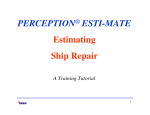
![G2 Decoder [obsolete] Second Generation User Manual](http://vs1.manualzilla.com/store/data/005963661_1-2c18e92993151caf68904a7a924089ff-150x150.png)
